2007 VOLKSWAGEN GOLF low oil pressure
[x] Cancel search: low oil pressurePage 288 of 444
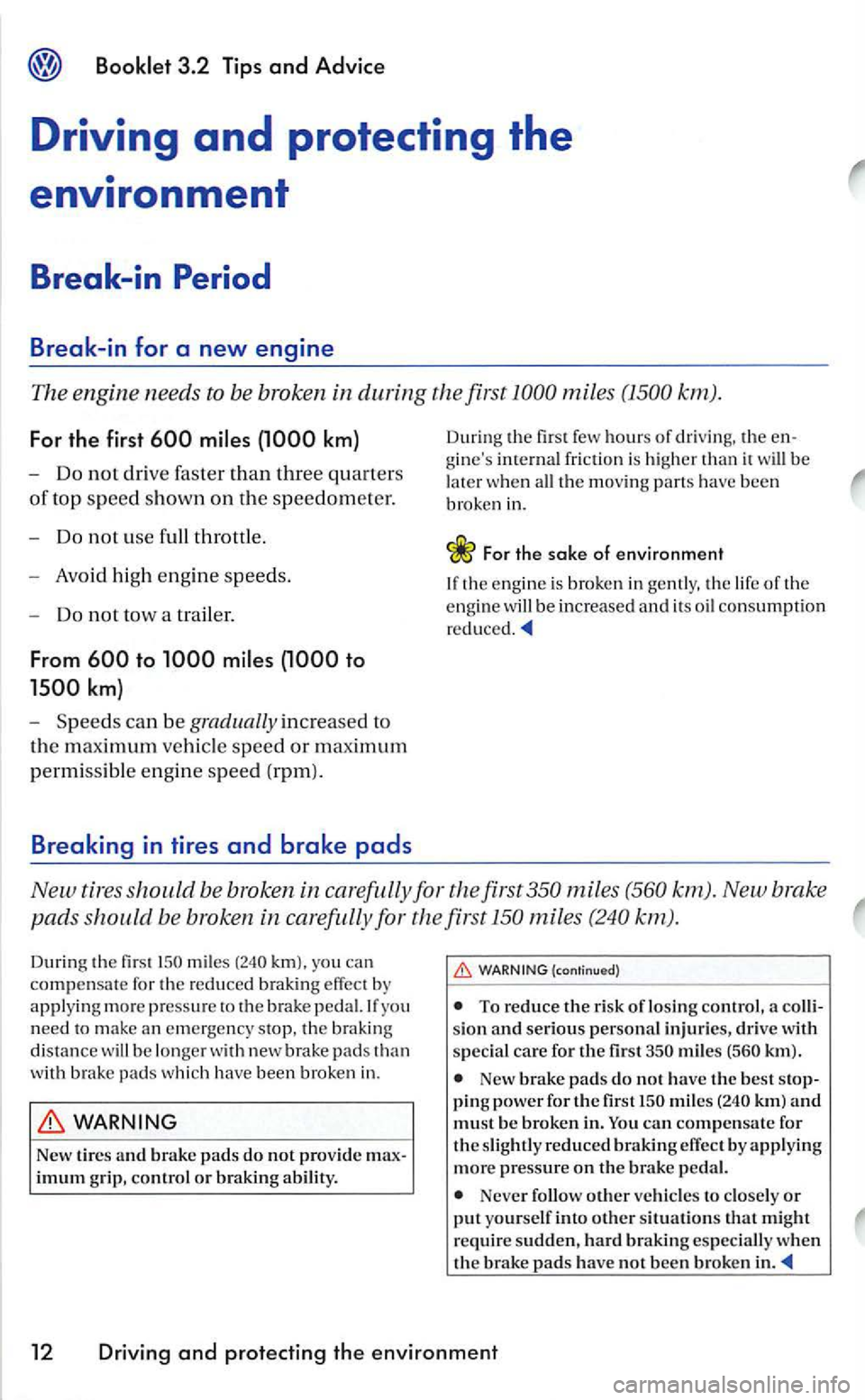
miles
can b e gradually in creased to
th e maximum vehicl e s
peed or maximum
permissibl e engin e speed (rpm ).
Breaking in tires and brake pads
Durin g the fir st few h o u rs of dri ving, the g ine 's inte rnal fric tion is hi gher than it will be
l a te r w he n a ll th e m ovin g part s have been bro ke n in.
For the sake of environment
th e eng in e is bro ke n in gentl y, the lif e of the engine will be in creased and it s oil co nsumption
New tires should be broken in carefull y for the fir st miles (560 km). New brake
pads b e broken in carefu lly for the first miles (240 km).
Durin g th e fir st miles km l. you can
c ompe nsate for the reduced brak ing effect by apply in g m ore press ure th e brake pedal.l fyo u
need to make a n em ergency slOp, the brak ing
di sta nce will b e longe r w ith new brake pads than
wit h brake pads wh ic h have been b roke n in.
WARNING
New tires and brake pads do not provide imum gri p, control o r braking
(cont;n ued)
To reduce the ri sk of losing a
miles
New brake pads do not have th e best pin g power for the fir st km) and must be broken in. can compe nsate for the s lightly reduced braking effect b y applying more pressure on the brake pedal.
N eve r follow other vehicles to clos ely or put yours elf into other situati on s that might require sudden, h a rd braking especially when the brake pads have not been broke n in.
12 Driving and protecting the environment
Page 289 of 444
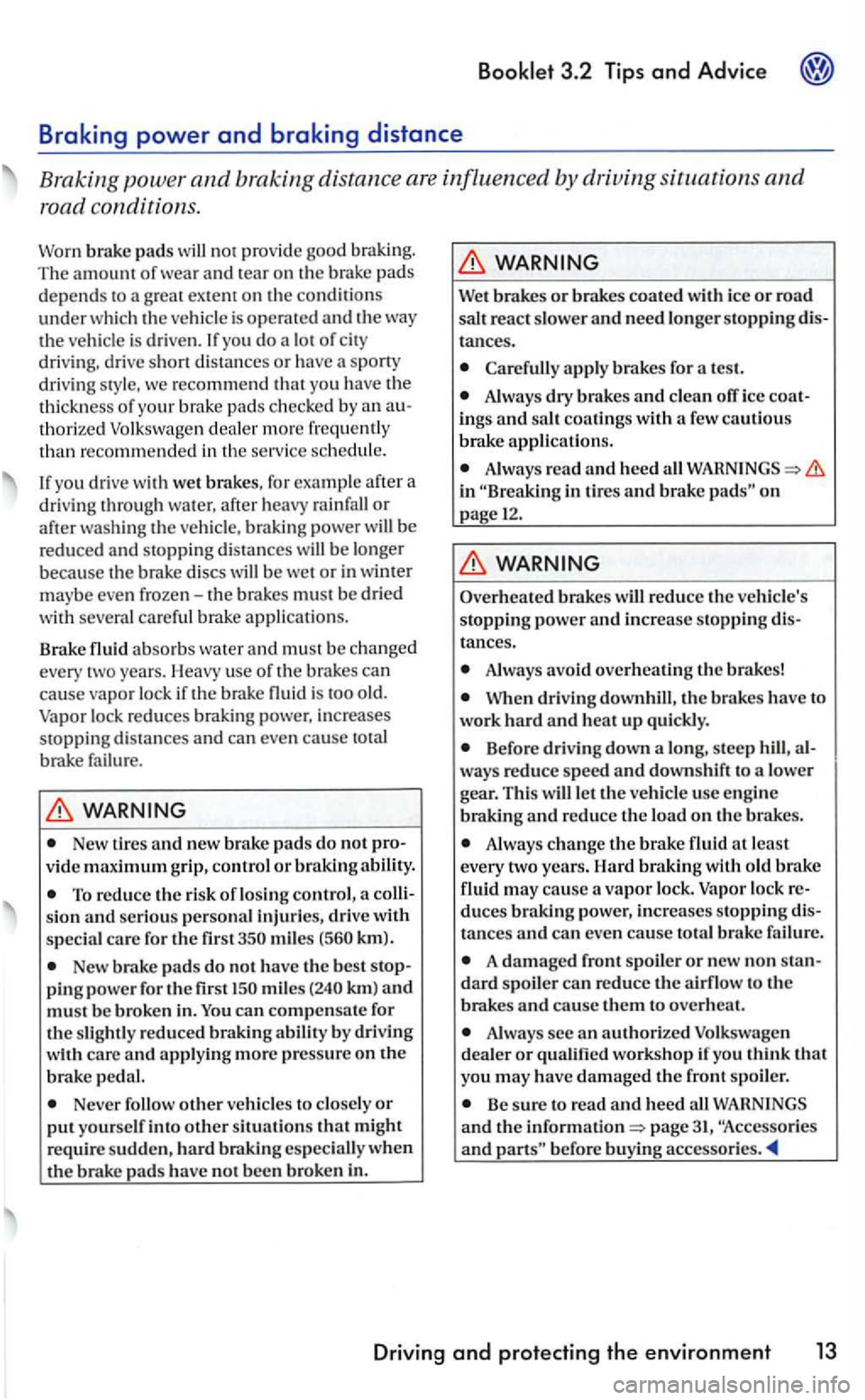
Booklet 3 .2 Tips and Advic e
recommend that you have the
thi ckne ss of your brake pads checked by an au
t horized Vol kswagen dealer mo re fre quent ly
t h an recommende d in the serv ice sched ule.
you drive with wet brakes, for example afte r a
dri ving through water, after heavy rainfall or after washing the ve hicle, braking power be
reduced and s to ppin g distances will be longer
because the brake discs will be we t or in winter mayb e eve n frozen-the brakes must be dried
with several ca re ful brak e applicatio ns.
Brak e fluid absor bs water
and must be changed
every two years. Heavy use of the brakes can cause vapor lock if the brake fluid is too old.
Vapor lock redu ces braking power, increases
stopping distances and ca n even cause total
brake failure.
New tires and new bra ke pads do no t pro
v id e m aximum gri p, control o r b raking abil ity.
To red uce the risk of l osi ng control, a s io n an d se rio us perso nal injuries, drive with
specia l ca re for the first 350 miles (560 km).
New brake pads do not have th e best sto p
ping power for the fir st ISO mile s (240 km ) and
m ust be b roken in. can compensate for the slightly reduced braki ng abil ity by dri ving care and applyin g more pressure on th e
brake pedal.
Never follow oth e r veh icles to close ly or
p u t you rse lf in to other s ituations th at might
requ ire su d den , hard bra king especially when the brake pads have not been broken in.
apply brakes for a test.
Always dry brakes and clea n off icc coat
i ngs an d salt coatings with a few cautious brake applications.
A lways read and heed in in tire s and brake on page 12.
Always avoid overheati ng the brakes!
When driving downhill, t11 e brakes have to
work har d and h eat up quickly.
Before driving down a lo ng, steep hill, al
ways reduce speed and downshift to a lower
gear. This will let the vehicle usc engine
Always ch ange th e brake fluid at l east
every two years. Hard braki ng wi th o ld flui d may cause a va po r lock . Vapor loc k duces powe r, inc reases stoppin g di stan ces and can even cause tota l b rak e failure.
A damaged front spoiler or n ew non standard spoiler can reduce t h e airflow to th e
brakes and cause them to ove rh eat.
Always see an authorized Volkswag en
dealer or qualified workshop
Be sure to re ad and heed all and th e page
Driving and protecting the environm ent 13
Page 316 of 444
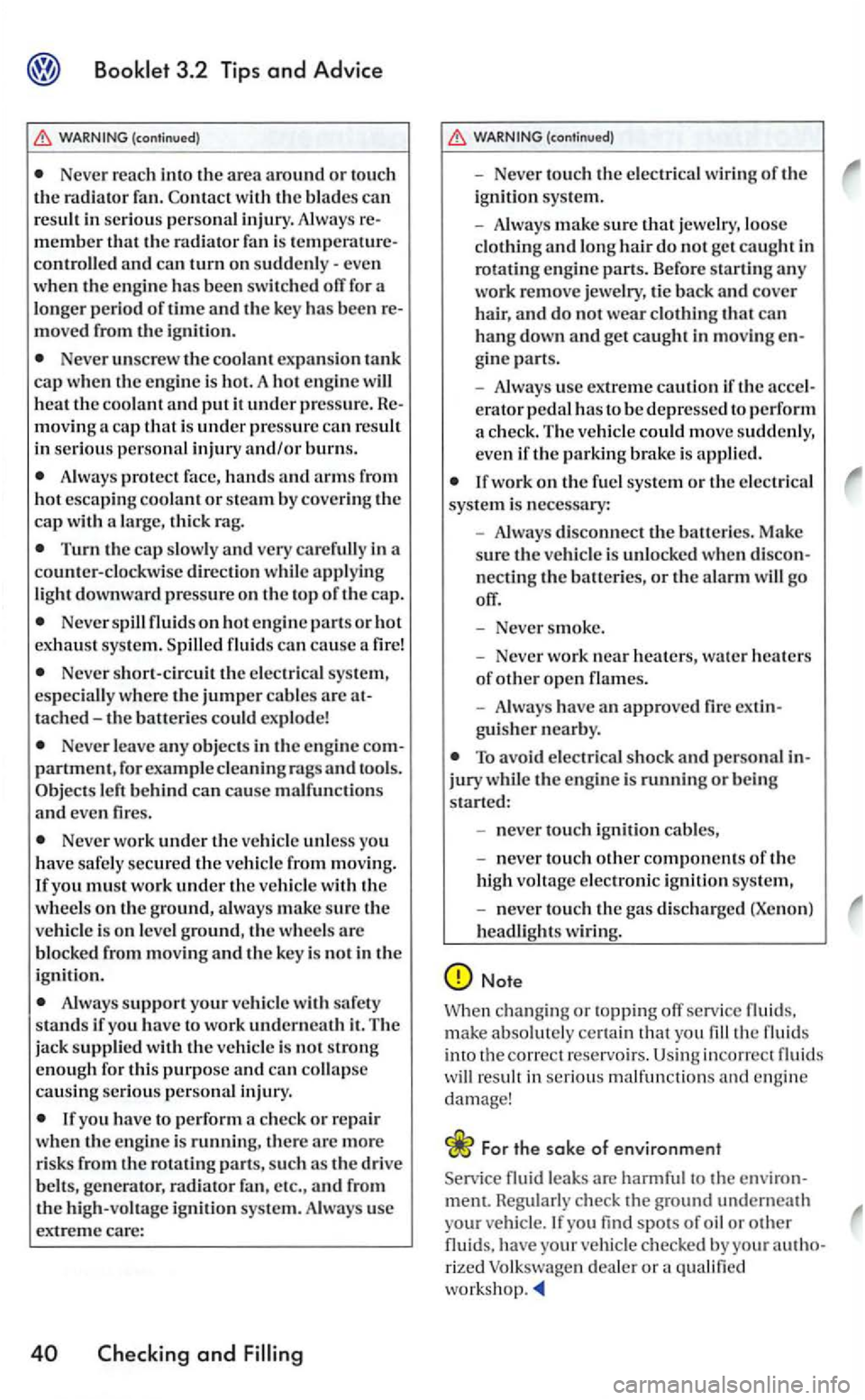
WARNING (continued)
Never reach into the area around or tou ch the radiator fan. Contact w ith the blade s can resuh in se riou s personal injury. Always m ember that the radiator fan is controll ed and can turn on
m oved from the ignit ion.
Never unscrew the coolant expa nsio n tank cap when th e engin e is hot. A hot engine will heat the coo la nt and put it under pressure . mov in g a cap that i s under pressure ca n rcsuh in seriou s personal injury and/or burns.
A lway s prote ct face, hand s and arms from hot esca ping coolant or steam b y cove ring the ca p with a large, thick rag.
Turn the cap slow ly a nd very carefully in a
counter- clo ckw ise direction whil e applying
light downward pressure on the top of the cap.
Never spill on hot engine parts o r hot
e xhau st sys te m . S pilled
Neve r short-circuitthc elec trica l sys te m ,
es peciall y w here th e jumper cabl es are tached -th e balleri es could explode!
Neve r leave any objects in the e ngine partment, for exam ple cleaning rag s and too ls. Objects
Neve r work unde r the veh ic le unless you
h ave safely secured th e ve hicl e from movin g.
I f yo u must work under th e ve hicl e wit h th e
w hee ls on th e ground, always make sure the vehicl e is on leve l ground, th e wh eels arc
b locked from movin g and th e key is not in the
ignition.
Always support your ve hicle with safety
s tands if you have to wo rk underneath it. The
ja ck suppli ed with the ve hicle is not s tron g enough for this purpose and can co llap se causin g se riou s personal injury.
If you have to perform a check or r ep a ir
w hen th e e ngine is running, there arc more
ri sks from
the ro tating parts, such as the drive
WARNING (con tinued)
Neve r to uch the e lec tr ica l w ir in g of the ig ni tio n sys tem.
Always make sure that j ewe lry, loose clothing and lo ng hair do not get caught in
rota ting engine pans. Before startin g any work remove jewelry, tie back and cover
hair, and do not wear clothing that can hang down and get caught in mov ing gin e parts.
Always use extre me cauti on if the erator pedal has to be depresse d to perform
a ch eck. The vehicle could move suddenly, eve n if the parking brake is applied.
If wor k on the fu el sys te m or th e electrica l
syste m is necessa ry:
Always discon nect th e balleries. Make
sure th e vehicle is unlo cked when
Neve r sm oke .
Neve r work nea r heaters, wa te r h eaters of other open names .
A lways have an approve d fire ext guis her nearby.
To avo id electrical shock and personal jury w hil e the eng ine is running or being
s tarted :
n ever touch ignition cables,
never to uch othe r component s of the
high vohage electronic ignition syste m,
never touch the gas discharged (Xeno n) headlights wiring.
Note
Whe n chang ing or topp ing orr service fluids. make absolutel y ce rtain that you fill the fluid s
into the corr ect reservoirs. Using incorrec t fluids will resuh in serious malf unct ions and engine
damage!
For the sake of environment
Service fluid leaks are harmful to the environ-
ment. Reg ularl y check the ground undernea th
your vehicle . you find spots of oil or other
fluids. have your vehic le checked by your rized dealer or a qualified
Page 319 of 444
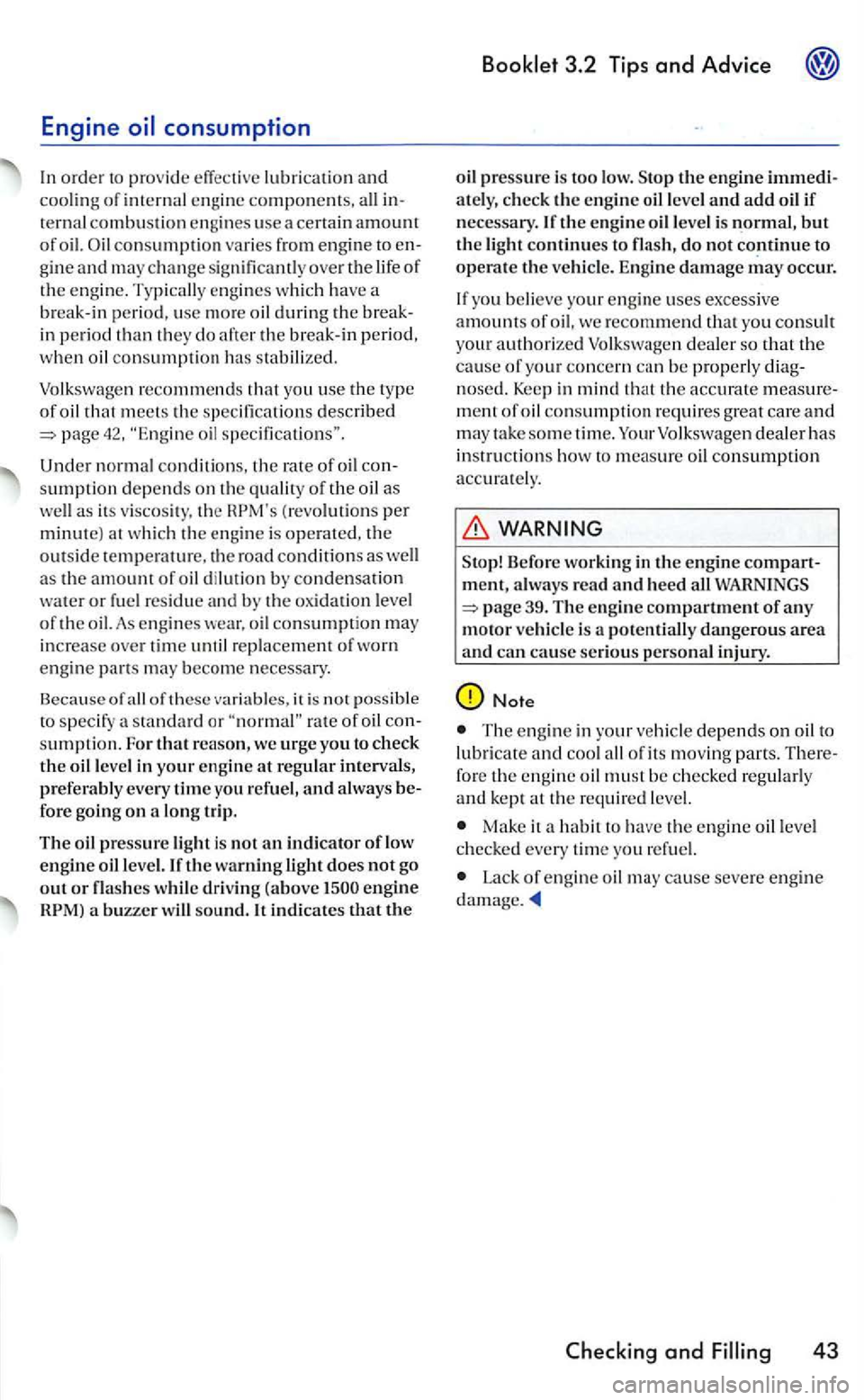
Engine
ternal combustion engines use a certain amount of oil.
th e break-in period,
when consumption has sta bili zed.
conditions, t he rate of
as its viscosity, th e
residue and by the oxidation level of the oil. As engines consumption may
increase over time
of thes e it is not rate of sumption. For reaso n, w e urge you to check the oil le vel in your engin e at regular interval s, prefe ra bl y every time yo u and always
fore go ing o n a trip.
The
en gine
pressure is too low. S to p the en gine ately, check th e en g in e o il leve l and add if
n ecessary . If th e e ng ine oil level is no rmal, but
th e light con tinues to flash, do not continue to
o pera te t he ve hicl e. Engine damage
so that th e cause of your concern can be pro perly
ment of consumpt ion requires great care and may take sometime. consumption
Sto p! Be fore workin g in the e ngine ment, always read an d heed all WARN INGS 39. The e ng in e compart m en t of any moto r ve hic le is a potentially dangero us a rea and can cause serious pe rsonal inju ry.
0Note
The eng ine in you r to all of it s movin g pa rts. fore th e en g in e must be ch ecked and kept at th e required
Make it a habit to have the engine
Lack of engine
and
Page 321 of 444
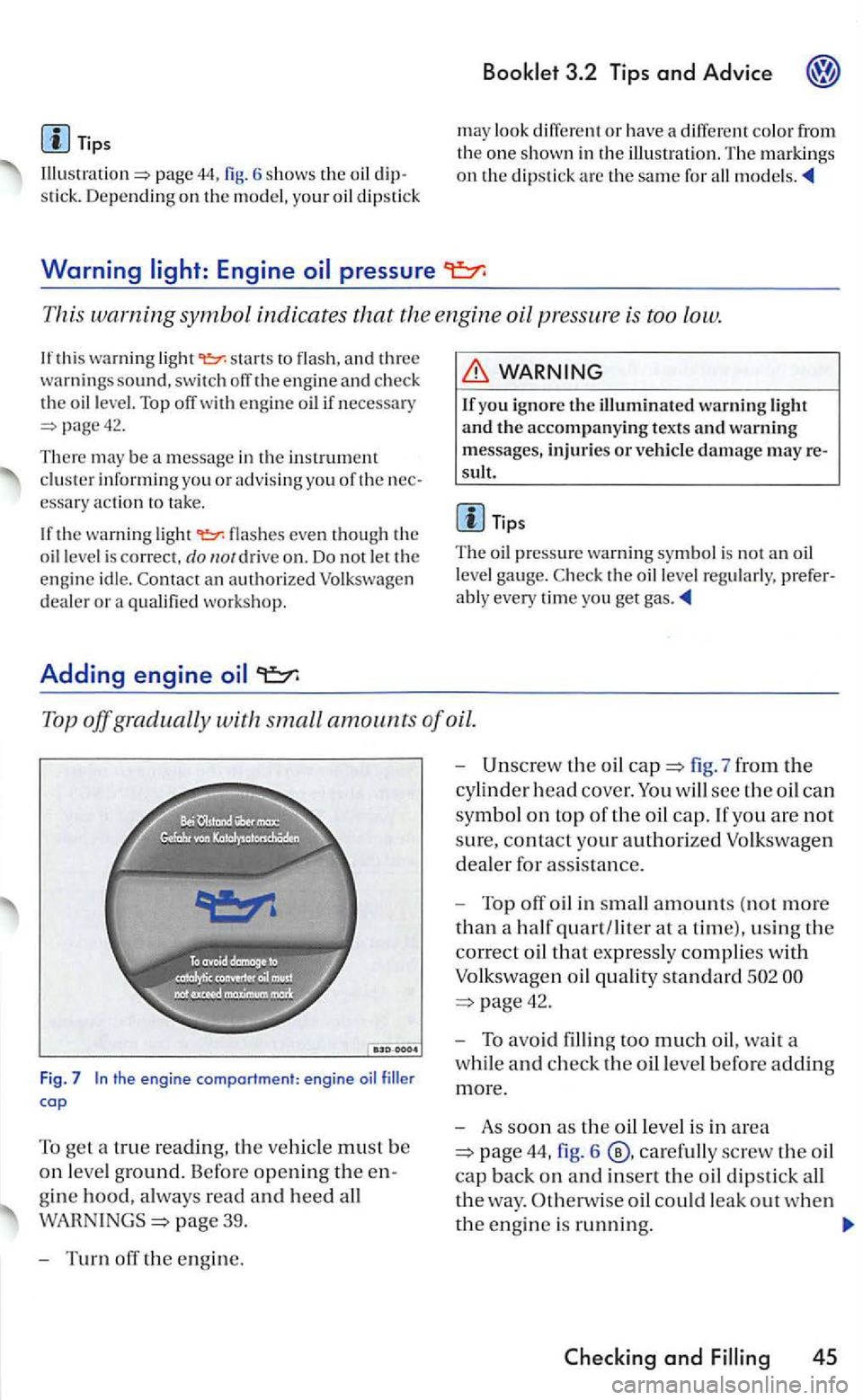
Tips
6 shows the oi l stick. Depending on the model, your dipstick
Booklet 3.2 Tips and Advice
may look different or have a different colo r from
t h e one shown in th e illustration. The markin gs on the dipstick are th e same for
Warning
This warning symbol indicates that the engine oil pressure is too low.
th is warning light start s to nash, and three warnings sound. switch off the engine and check the oil level. Top off with engine oil if necess ary
essary action to tak e.
If
the warning flas hes even the
oil le ve l is correct, do no/drive on. Do not ler the engine idle. Contact an authorized Volkswagen dealer or a qualified works hop.
Adding engine
WARNING
If yo u ignore the illum inated warning light and the accompanying texts and warning messages, injuries or vehicle damage may s ult.
Tips
The oil pressure warning symbol i s not an oil
level gauge. Check the oil leve l regu larly,
Top off gradually with small amounts of
Fig. 7
must b e
on leve l ground. Before opening the
WAHNINGS 39.
Turn off the e ngin e.
Un screw the oil fig. 7 from the
cy lind er head cover. see the can
symbol on to p of the oil cap. If you a re not
sure, con tact your authorized
off oil in amounts (not more
than a hal f quart/liter at a time). using the
correct oil that expressly complies with
quality standard
page42.
too much
As soon as the oil l evel is in area
d ipstick all
the way. Othetw ise oil could
and Filling 45
Page 334 of 444
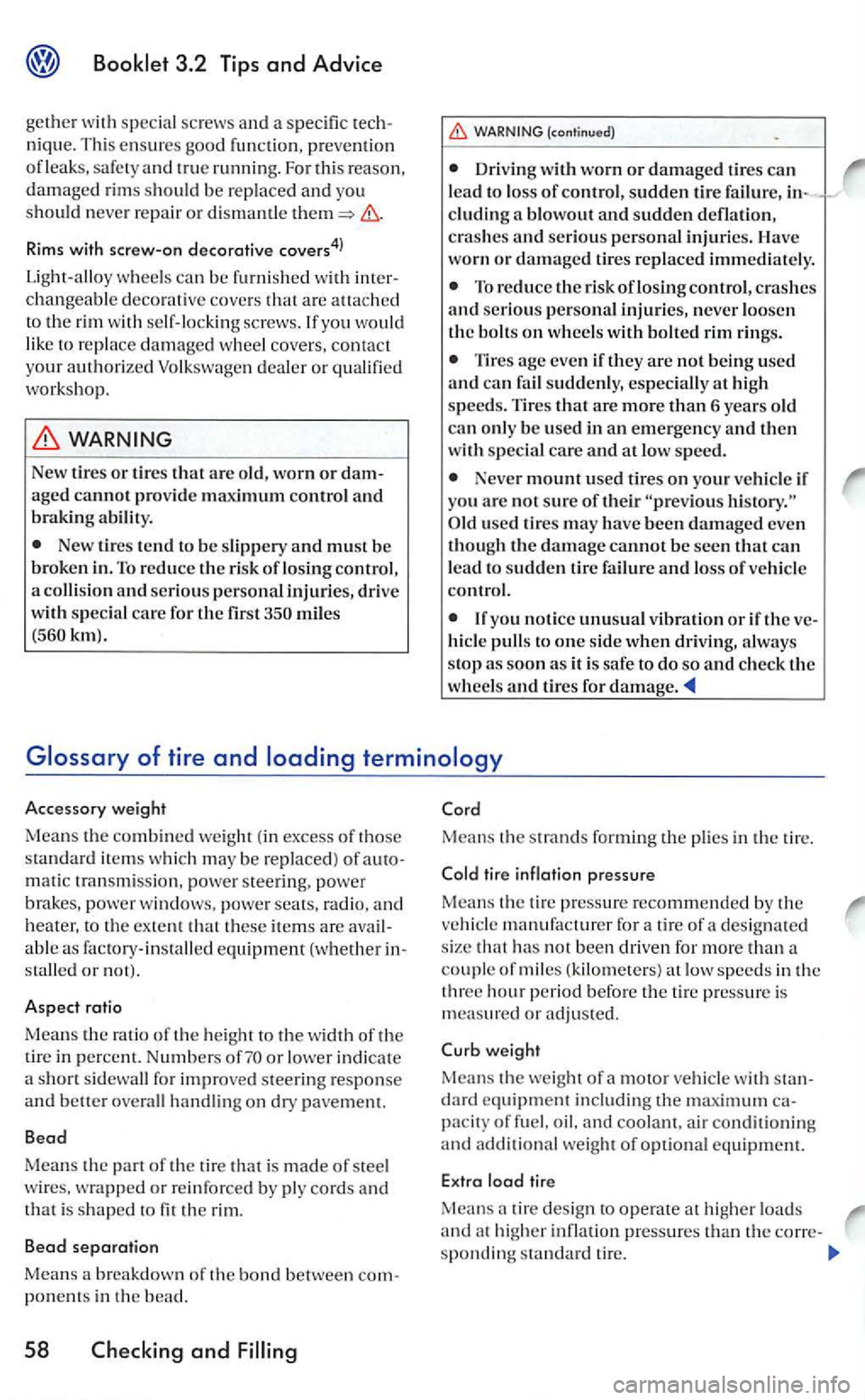
changea ble deco rat ive cove rs a re att ached to th e rim with s elf- locking sc rews . lfyou would ro re pla ce damaged wheel covers, contact your authorized Volkswa gen d eale r or
WARNING
New ti res or tires tha t are old, worn or aged cannot provide maximum control and braking ability.
New tires tend to be s lipp ery and must be broken in . To reduce the risk of losing co ntrol,
a co llisio n and serio us personal injuri es, drive with sp ecia l care for the first km).
(cont inued )
Driving with worn or damaged tire s can lead to lo ss of control, sudden tire failur e, cluding a blowou t and sudden deflation ,
c ras hes and seriou s personal injuries. Have wo rn or damaged tires rep laced imme di ate ly.
To redu ce the riskoflosingcontrol, crashes and s erio us personal injuries, never loose n
th e bolts on w heels with bolted rim rings.
more than 6 years old can onl y be used in an em erg en cy and then
w ith specia l care and at low speed.
Neve r m ount u se d tires on your ve hicle if
yo u are not sure of their used tires may have been damaged ev e n
t h oug h the damage cannot be seen th at can
lead to sudden tir e failure and loss of ve hicl e control.
hicl e pull s to one sid e when dri ving, always
s top as soo n as it is safe to do so and ch eck the
whee ls and tires for damage.
Accessory weight
Means the combined we ight ( in excess of those
sta ndard ite m s w hi ch may be repl aced) of mati c tran smission. power steering. po wer
bra kes, power windo ws. p owe r seats , radio, and heater, to th e ex te nt th at th ese item s are
or lowe r indica te
a short s id ewall for improved steering respo nse and better ove rall handling on dry pave ment.
Bead
Mean s the pa rt of the tire t hat is m ad e of stee l
wires , w rap ped or re inforce d by pl y cords and that is shap ed to fit t he rim.
Bead separation
Mean s a breakdow n of th e bond between
Means the strand s forming the in th e tire.
weight
Me ans th e weig ht of motor vehicl e w ith dard equ ipment including the m aximum pacity of fu el, oil. and coolant . a ir conditio nin g
a nd additional weight of opt io n al equipm ent.
E xtra load lire
M ea ns tire desi gn to operate at higher loads and at hi gher inflat ion pressure s th an th e corre -
s ponding sta ndard tire.
Page 386 of 444
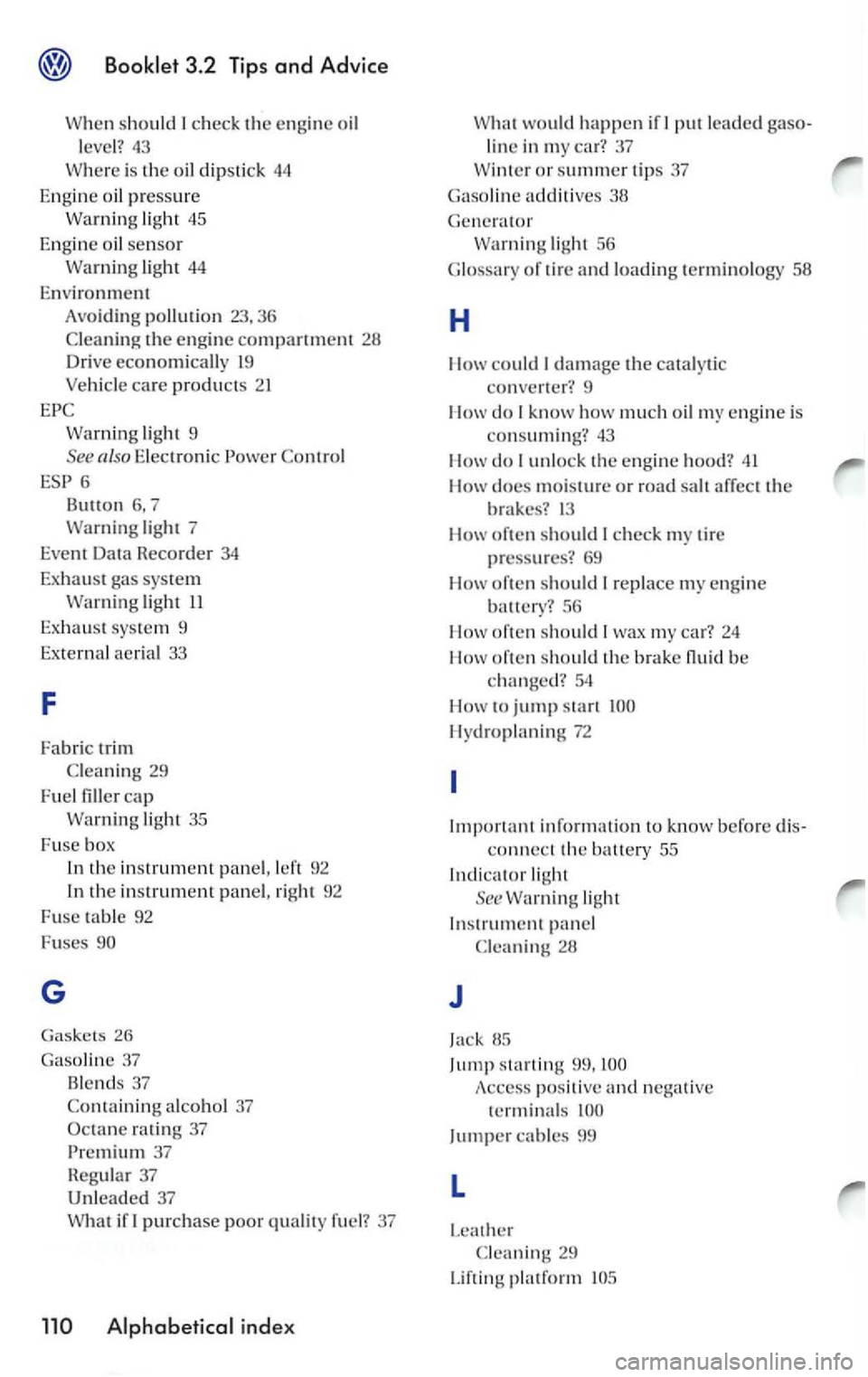
sh o uld I check the engine oil
level? 43
ligh t 45
Engine oil sensor li g h t 44
Environment Avoiding pollution 23, 36
the eng in e compartment 28 Drive economically 19
light 9
also E lectron ic
light 7
Even t Data Hecorder
34
Exhaus t system
light II
Exhau st system 9
Externa l
aeria l 33
F
Fabric trim
light 35
Fuse b ox
I n the in strument p anel , left 92
In the in strum ent pan el, rig h t 92
table 92
Fuses
G
Gaskets
Gasoline 37
Blends 37 alcohol 37
rating 37
37
Hegular 37 Unleaded 37 ifl purchase poor qua lity fu el? 37
woul d happen if I put leaded gaso
l
ine in my ca r? 37
or summer tips 37
Gasoline addi tives
Generator light 56
G lossary oft ire and loading terminology 58
H
I low co uld I damage the cata lytic
conve rter? 9
I low do I know how much oil en gi ne is
consuming'? 43
How do I unlock the en gine hood? 41
How doe s moisture or road salt affec t the brakes? 13
How ofte n should I check my tire
pressures? 69
How often should I replace my engine
battery?
56
How oft e n should I wax my 24
I low ofte n should th e brak e nuid be
c h anged?
54
I low to jump start
light
I n st
rument pane l 28
J
Jack
Jump starti n g
Access positive and negative
terminals
Jumper cables
L
Leather